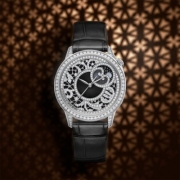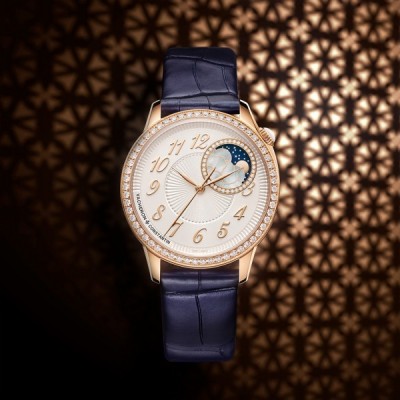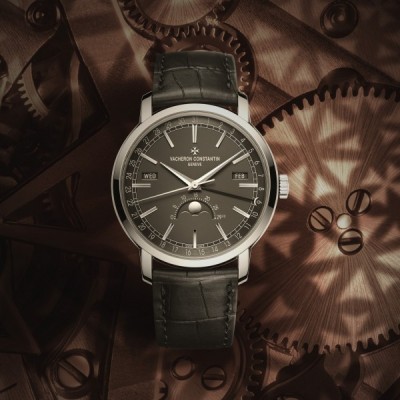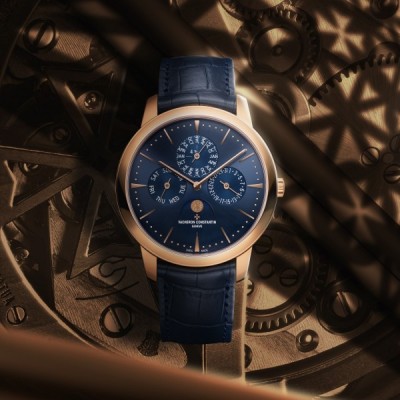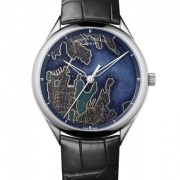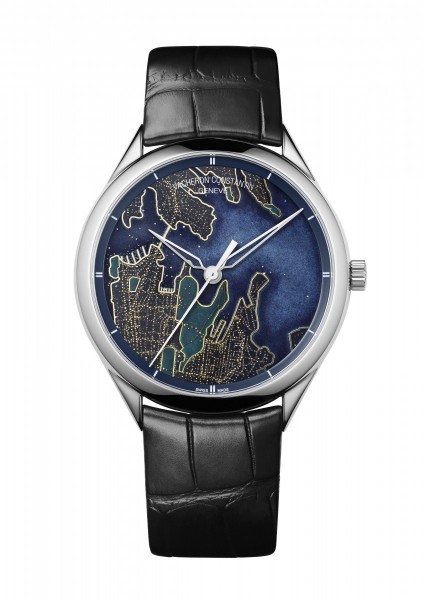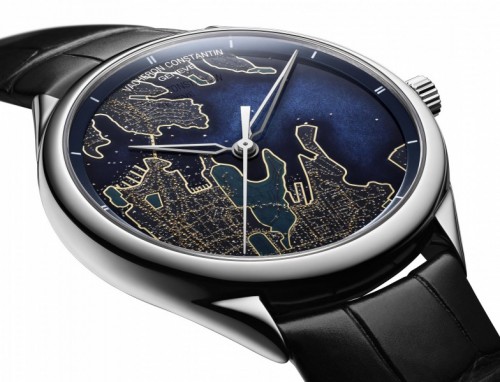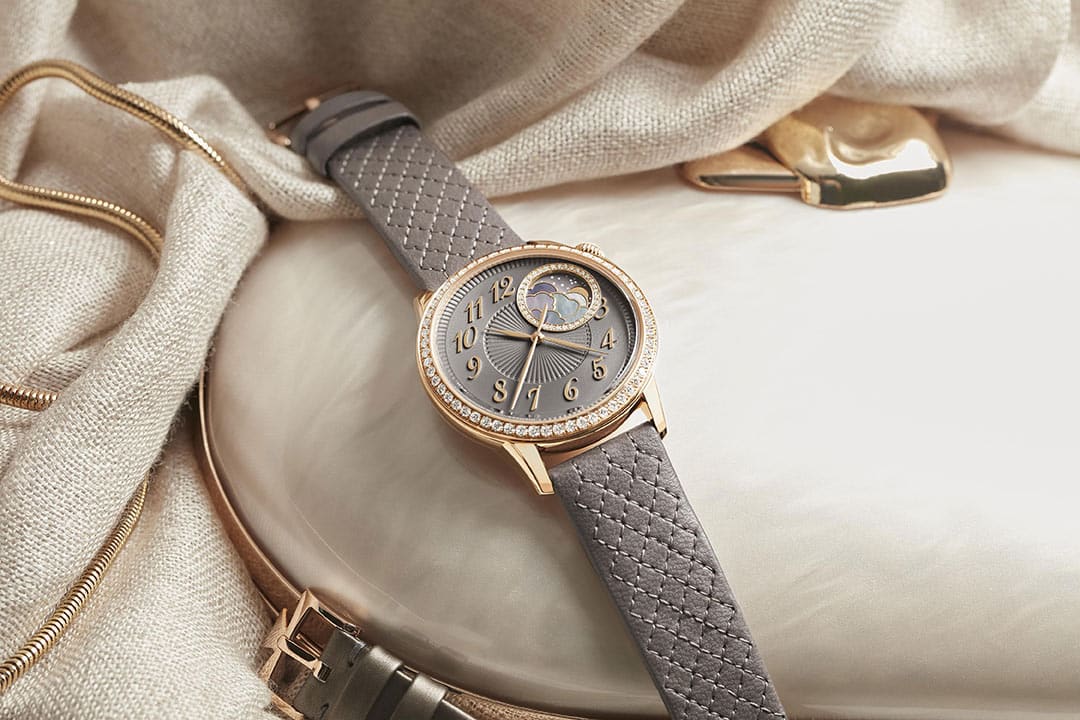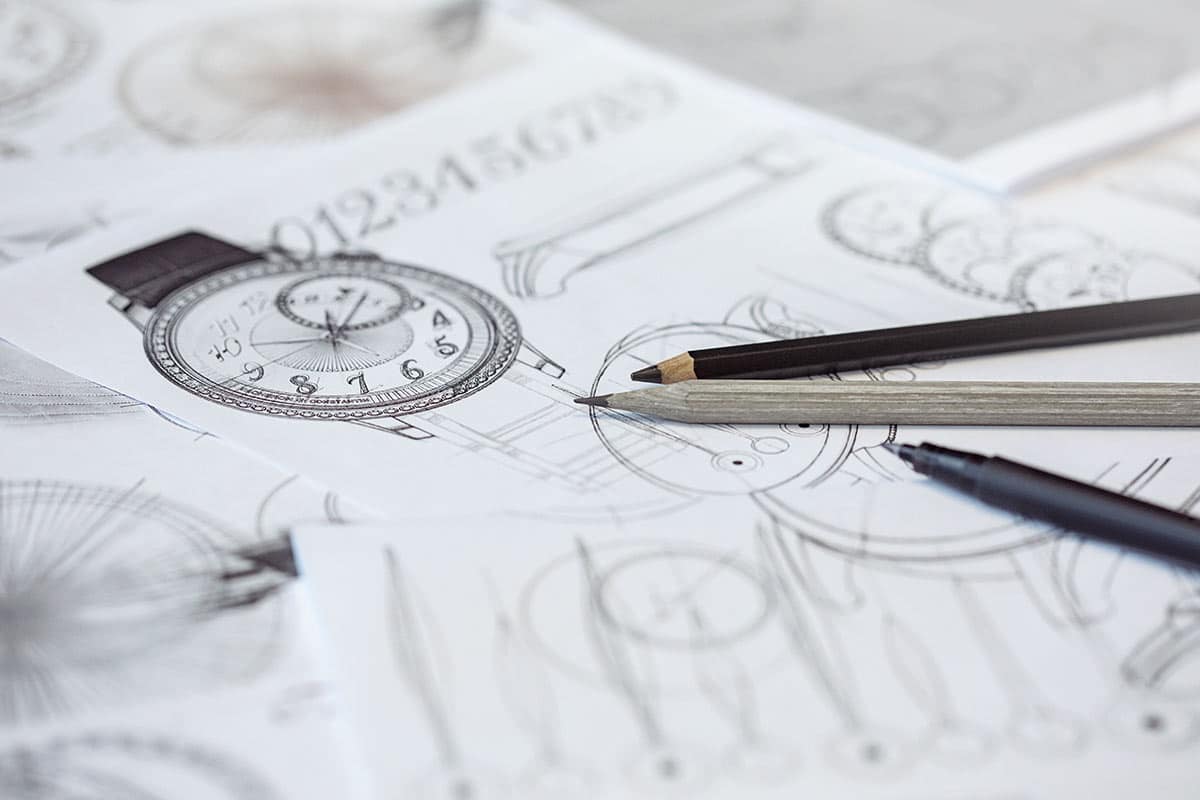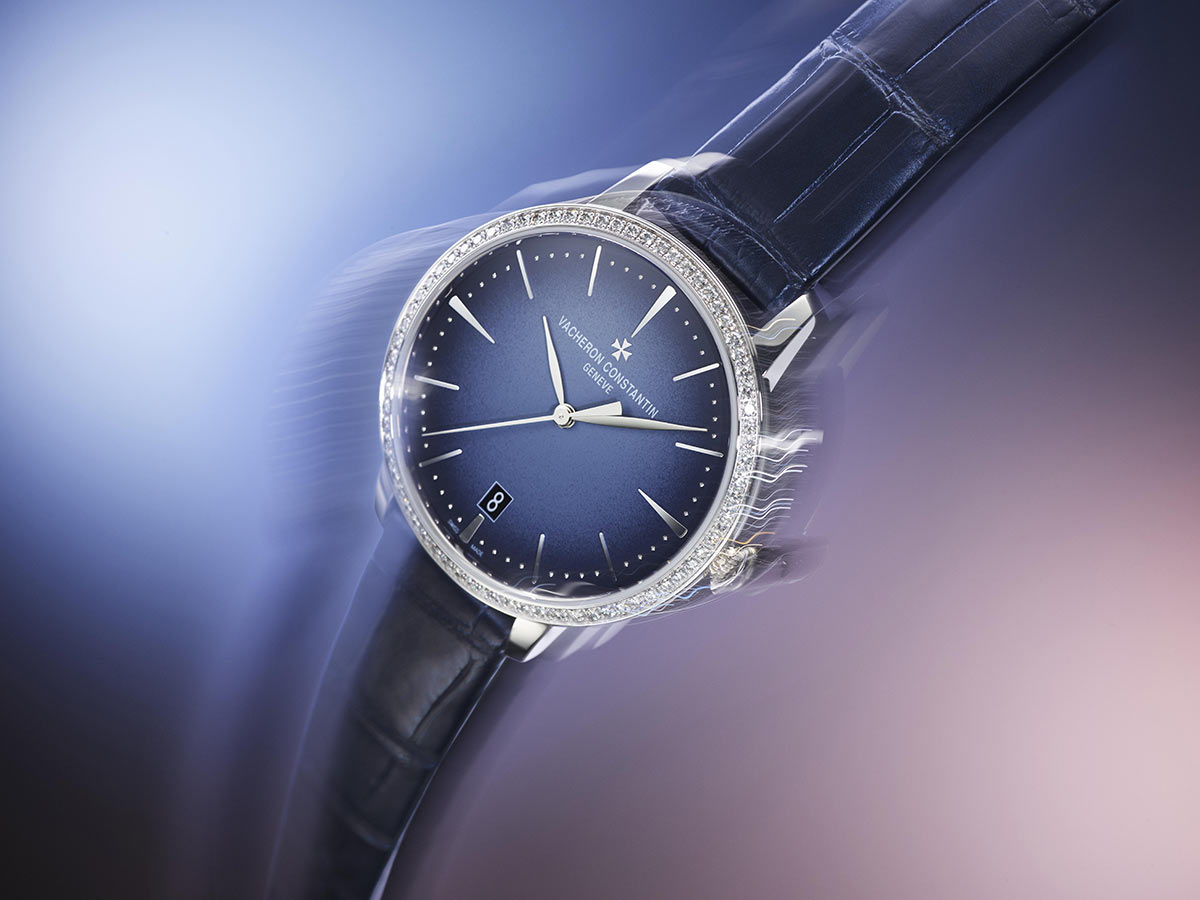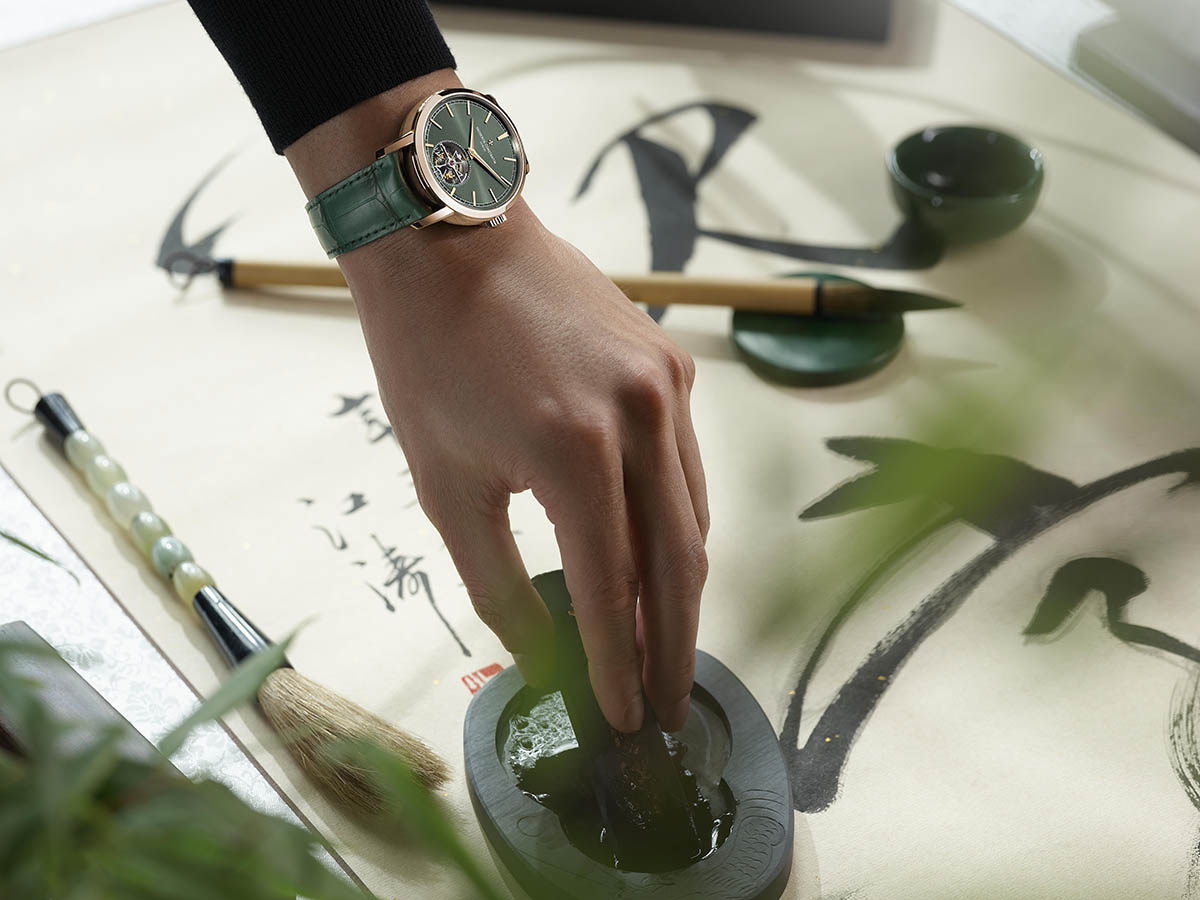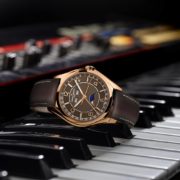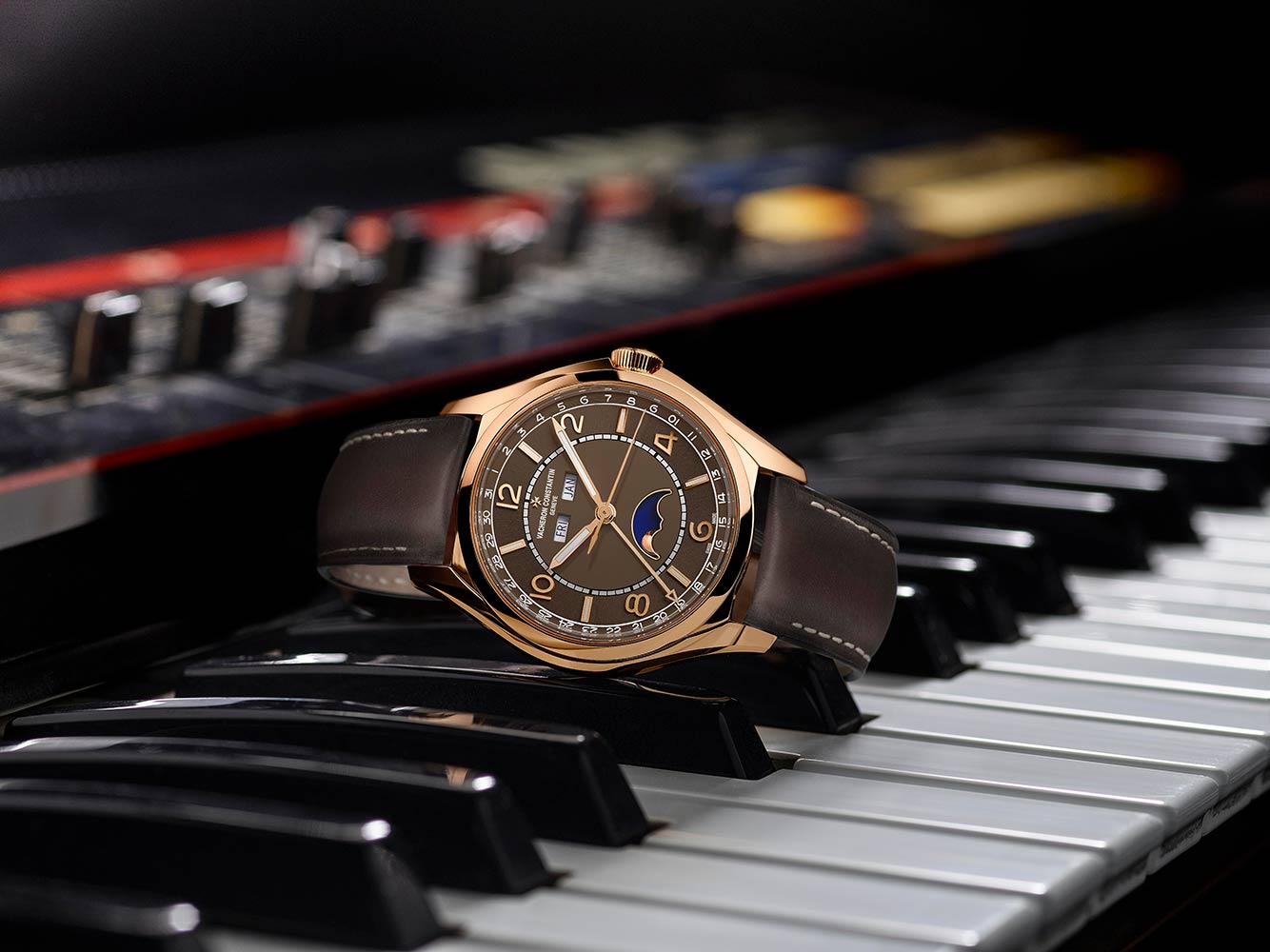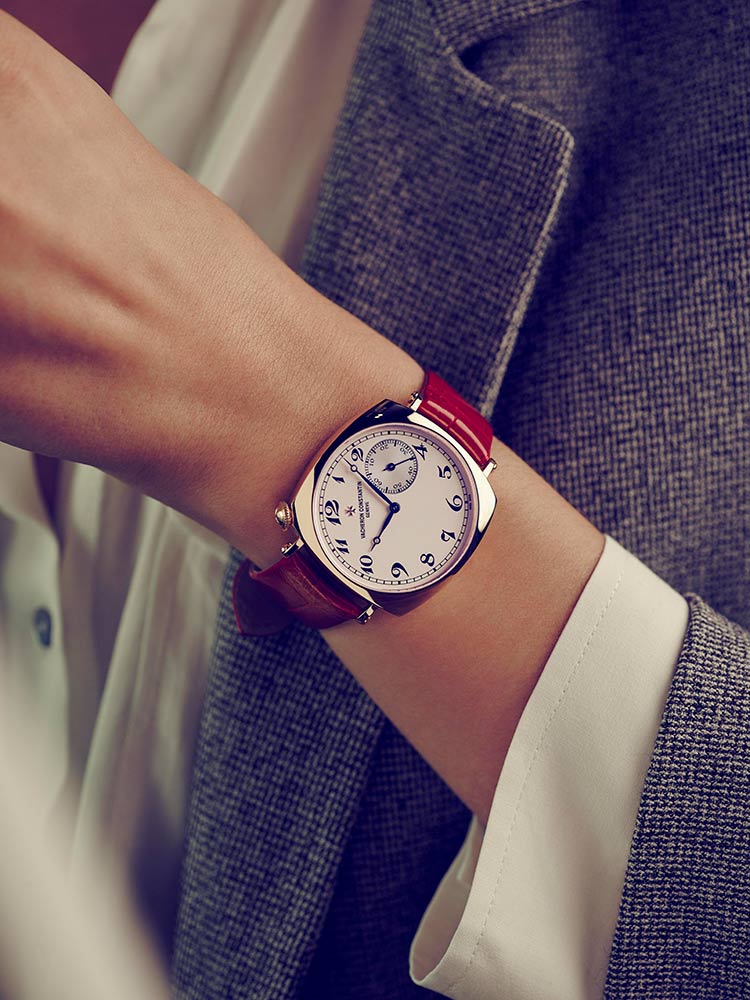Vacheron Constantin
High Watchmaking: Astronomical watches
- Horology stems from the observation and study of the stars dating right back to the earliest ancient civilisations
- Twenty years after its foundation in 1755, the first watches with astronomical indications appeared at Vacheron Constantin.
- The Manufacture has developed a rare breed of expertise in Grand Complication watches dedicated to the movement and influence of the moon, stars and planets.
Geneva, November 17th 2021 – Horology, the science of time measurement, was born from the observations of heavenly bodies and natural cycles. The mechanical instruments developed by horologists stem from these observations, reflecting an art that has continued to progress since the late Middle Ages. Founded in 1755, Vacheron Constantin developed a perfect mastery of astronomical indications at a very early stage, progressively enriching it over the two and a half centuries of the Manufacture’s existence. Today, the Maison produces watchmaking masterpieces of great astronomical complexity.
Astronomical watches remind us of the origins of watchmaking. Born of the observation of the great physical laws of Nature, the measurement of time is in fact a material extrapolation of the movement of the stars and cycles. This mechanically translated interpretation has given rise across the ages to timepieces capable of offering a wide variety of functions, and of varying degrees of complexity, linked to the singularities of the Gregorian calendar, to the various temporalities governing our universe, or to the motion of heavenly bodies and their impact on the Earth. Although many of these functions are not of practical use, they nonetheless testify to expertise that is all the rarer in that it lends a cosmological dimension to these watches forming a link between humankind and the universe. From its earliest days, Vacheron Constantin has shown great interest in watches with astronomical functions, including various types of calendar displays and indications of the phases and age of the Moon, often combined with other horological complications. Since the 2000s, this technical mastery has been illustrated in particular through its Les Cabinotiers department, whose astronomical watches are masterpieces of their kind.
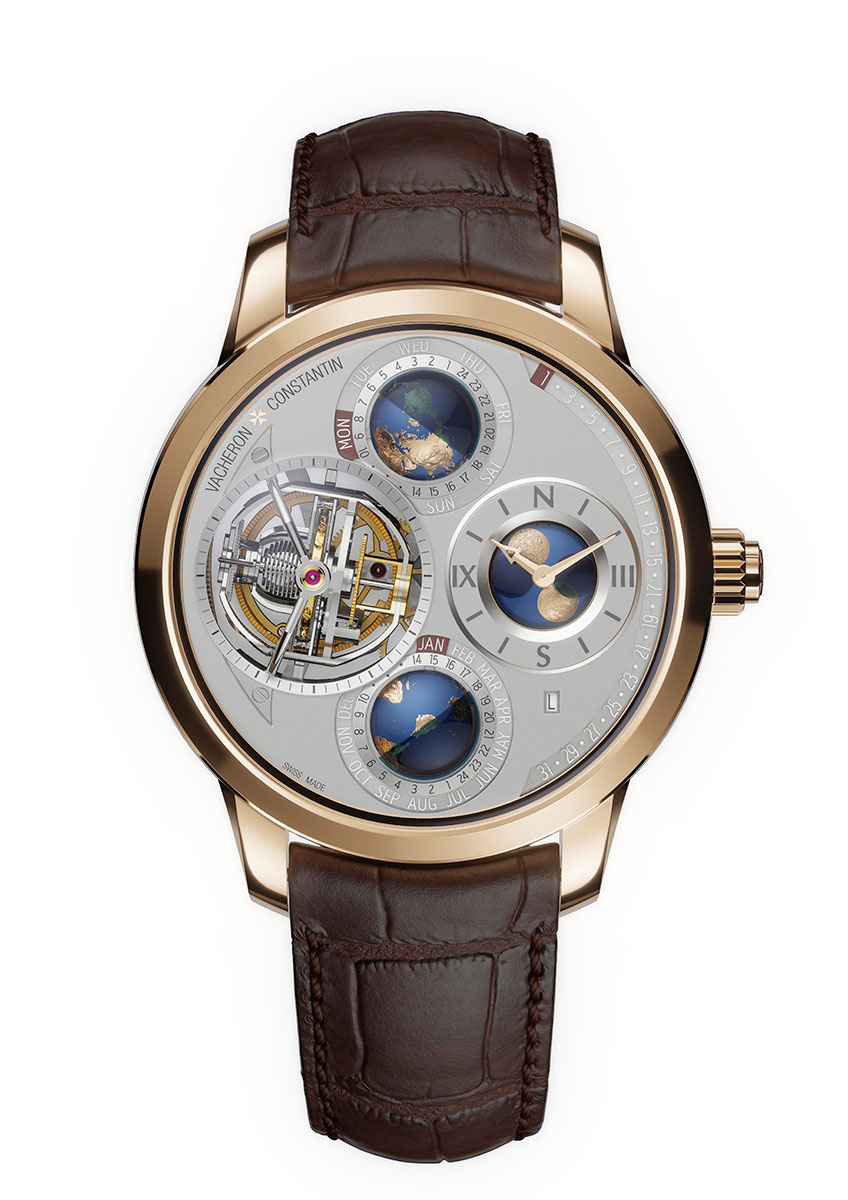
Astronomical functions
The astronomical functions of a wristwatch include indications related to the particularities of the Gregorian calendar, as well as a wide variety of displays related to the movement of the stars. In addition to the main functions listed below, the most complex of them may offer a system for predicting lunar and solar eclipses, the position of the stars as seen from the Earth, displays of the ephemerides (solstices, equinoxes, seasons), the signs of the zodiac, a tideograph, sunrise and sunset, the duration of day and night, the annual deviation or angular movement of the Moon, etc. All this bearing in mind that a good number of these functions are valid exclusively for a given location. The most “common” astronomical watches include one or more of the following indications.
A simple calendar watch is a watch that, in addition to the time, provides calendar information – usually the date – but whose mechanism does not automatically keep step with the irregularity of successive months. When such a calendar also provides indications including the day of the week, phases of the moon and even the year, it is called a complete calendar. This type of complication requires five adjustments per year. Unlike a simple calendar, an annual calendar automatically takes into account the irregularity of 30- or 31-day months, except for February, meaning that manual adjustment is required on March 1st each year. A perpetual calendar, on the other hand, indicates calendar functions such as the date, month and day of the week, taking into account months with 28, 30 or 31 days, as well as leap years.
The moon-phase indication is frequently associated with the perpetual calendar. It serves to reproduce the cycle of Earth’s satellite (new Moon, first quarter, full Moon, last quarter) on the watch dial. The phases of the Moon should not be confused with the age of the Moon which indicates the time (in days) elapsed since the last new Moon.
The equation of time is defined by the difference between solar time – or true time – and civil time – or mean time. The former is the time as shown on a sundial, while the latter is the time displayed on a watch. The difference between the two ranges from -16 minutes to +14 minutes and occurs during the course of the year, due to the Earth’s elliptical orbit and the tilt of its axis.
The time it takes for the Earth to complete one full spin on its axis (360°) is 23 hours, 56 minutes, 4 seconds, and is called the sidereal day. Because of the Earth’s revolution around the Sun and its rotation on its own axis, the solar day – the time difference between two passages of the Sun through the zenith point (meridian) – lasts a few extra minutes. Using a fixed star in the sky instead of the Sun as a reference point, this sidereal time is used as a basis for astronomical observations.
The sky chart is a planispherical representation on a disc or dial of the sky at a given location on the globe. This surface is rotated at a rate of one revolution per year – thereby offering a ‘snapshot’ of the sky at a given time – or of one revolution per sidereal day, which provides a view of the sky in real time.
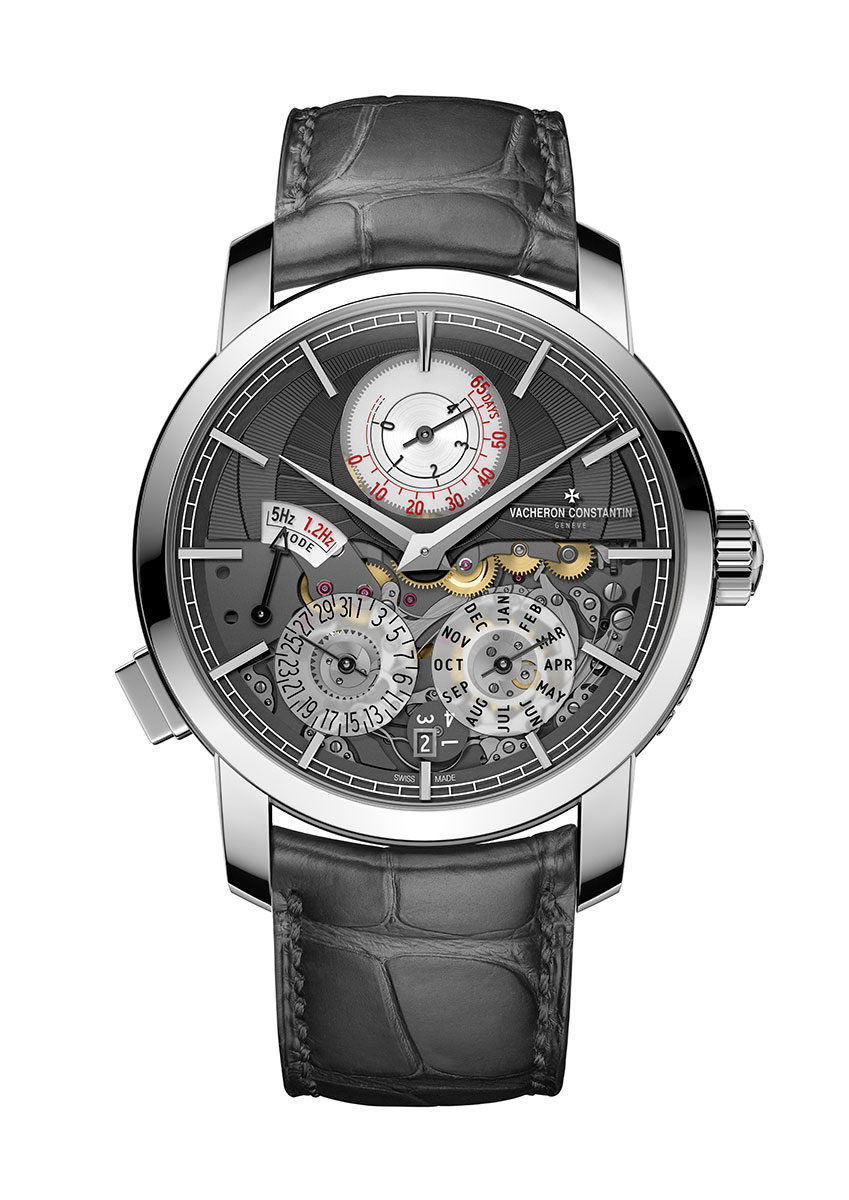
Advanced mechanics
The perpetual calendar is often considered one of horology’s finest gems for its ability to display the exact date for an all but infinite duration (with the exception of secular years not divisible by 400), taking into account the variable length of the months and the leap-year cycle. To accomplish this mechanical feat, the movement must have a “memory” of 1,461 days, equivalent to four years. The essential component of these mechanisms is the month cam on which the different monthly durations are programmed. Equation of time mechanisms are also governed by a cam – which is in this case asymmetrical, performs one revolution in a year and features a shape derived from the analemma.
This results in a one-day discrepancy for this type of mechanism that must be corrected every 2 years and 7 months. Watches with a precision moon-phase display have a wheel with 135 teeth. With this system, the deviation from the lunar cycle is reduced to one day every 122 years. Another astral representation is the rotating sky chart, of which the visible part corresponding to the skyline is delimited by an ellipse, and which generally makes one revolution in one day in order to offer a vision of the sky in real time.
This rotation is calculated according to sidereal time, which is 3 minutes and 56 seconds shorter than the average day. Technically, the simplest solution consists of integrating two kinetic chains in the movement, from the barrel to the regulating organ, the first beating at the mean solar time rate of one revolution in 24 hours and the second at the slightly faster sidereal time rate of one revolution in 23 hours, 56 minutes and 4 seconds.
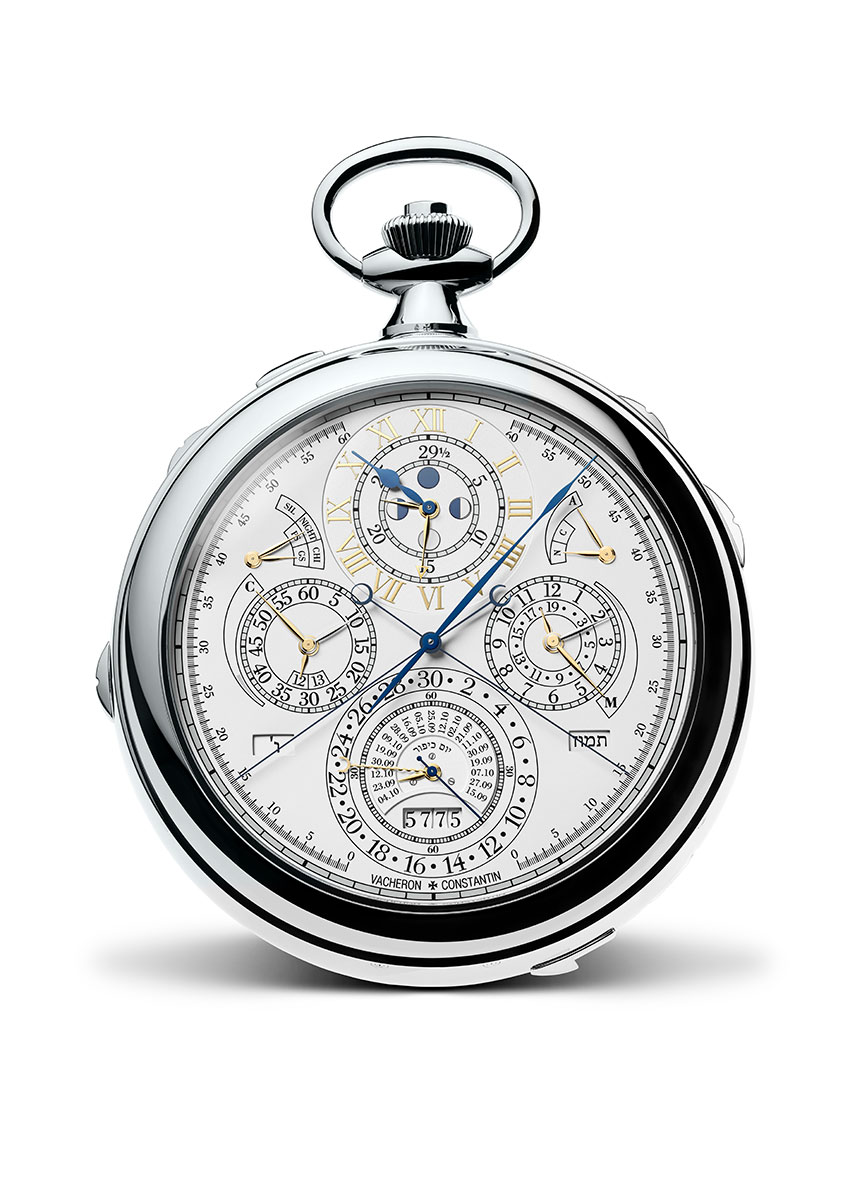
Astronomical paternity
The appearance of megalithism around 5000 BC owes nothing to chance. These thousands of precisely oriented stone monuments – of which one of the best-known is the circle of menhirs at Stonehenge – are regarded as the first astronomical observatories. It was however not until around 4200 BC that these first observations took on a more scientific nature, when the birth of writing played a decisive role by making it possible to record events, perform calculations, establish chronologies and make forecasts. Writing appeared in Mesopotamia, and gradually became established in Egypt in the following century – and then some 2,000 years later in China and the Mayan Empire. Each great civilisation then set about developing its own calendar based on the visible movement of the Sun or the Moon, or both.
It was the Mesopotamians, around 2400 BC, who invented a common unit of measurement for calculating distances and time, which is still the basis of our sexagesimal system of degrees of angle and minutes today. This spatialisation of time was decisive when it came to sequencing it according to the course of the stars. The development of mechanical engineering, which already emerged at the time of Aristotle, was thus able to give shape to the counting of time and its astronomical dimension. As soon as the first clocks appeared in the 13th and 14th centuries, mechanical horologists set out to reproduce on dials the movements of the solar system’s main planets. The pocket watches of the Renaissance were direct heirs to these large astronomical clocks. Well before the invention of the minutes hand, these watches already indicated the time, the date, the days of the week, the months and their duration, the moon phases and the signs of the zodiac. These astronomical watches, which were very popular in the 17th century, are still considered to be models of their kind today.
From that time onwards, ingenious watchmakers redoubled their efforts to make their mechanisms more accurate – resulting in the appearance of minutes and then seconds hands – and more compact. This miniaturisation naturally made it difficult to depict certain astronomical functions, except for the date and its most sophisticated perpetual calendar interpretation, accompanied by a moon-phase display. As of the 19th century, any Grand Complication watch had to incorporate a mechanism capable of following the irregularities of the Gregorian calendar. At that time, some exceptional pocket watches also reproduced celestial mechanics by displaying the equation of time, sunrise and sunset times or sidereal time. These functions can be found in the highly complicated timepieces of the first half of the 20th century. The advent of the wristwatch, however, put a stop to these technical masterpieces – while nonetheless not provoking their complete disappearance. Since the revival of the mechanical watch at the end of the 1980s, the astronomical watch has enjoyed a clear resurgence in interest and currently represents a supreme demonstration of expertise.
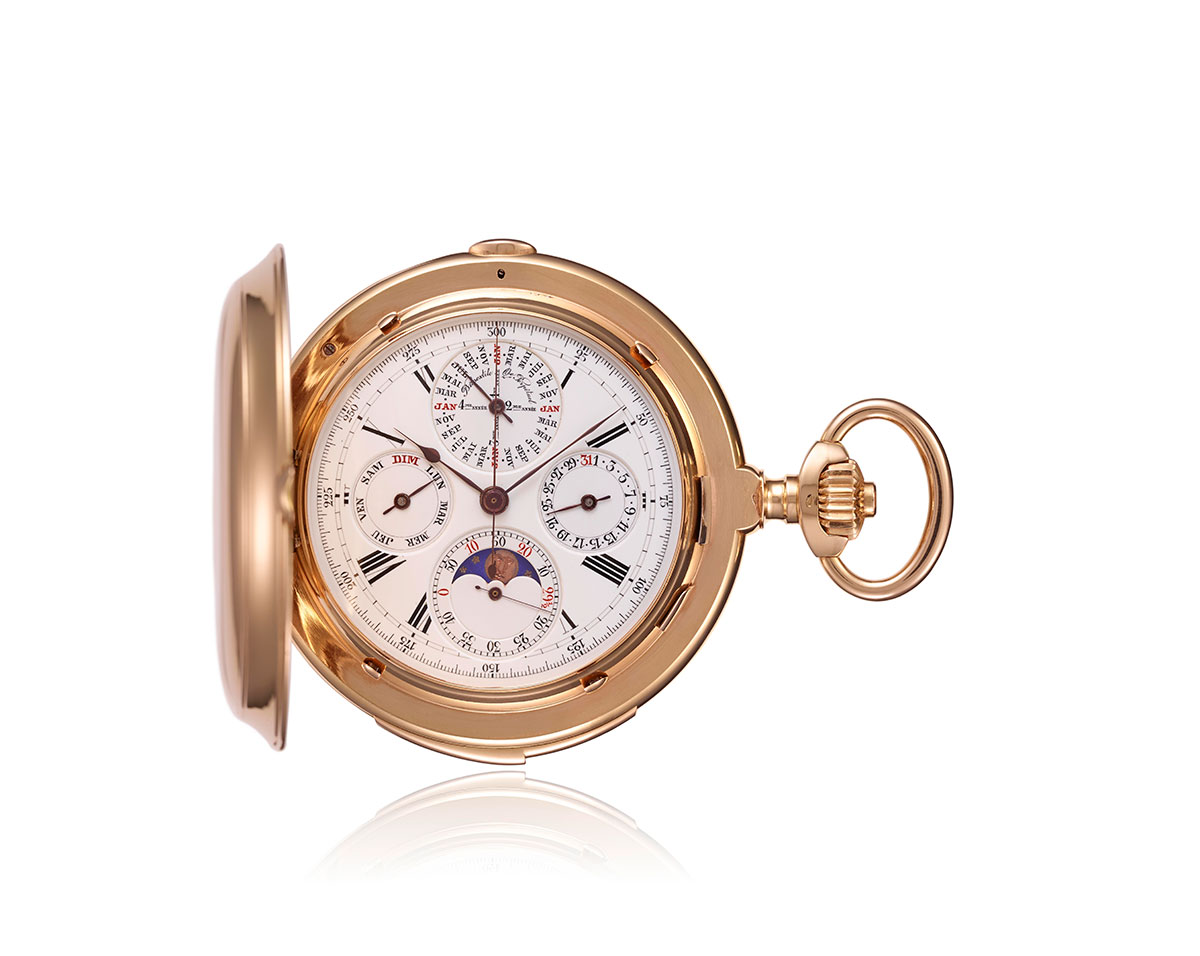
Vacheron Constantin and calendar watches
The first mention of a pocket watch in Vacheron Constantin’s records dates back to a period prior to 1773, i.e. the early years of the workshop founded by Jean-Marc Vacheron in 1755. A decade later, the range of complications developed under the leadership of Jean-Marc’s son Abraham Vacheron, notably exemplified by the first complete calendar dating from 1785 and appearing on a brass dial with a floral motif. The archives of the Maison accurately retrace this progressive mastery of astronomical complications, beginning in 1829 with the first recorded order for a watch featuring a simple calendar and moon phases, and again in 1884 for a perpetual calendar integrated into a double-sided yellow gold pocket watch now belonging to Vacheron Constantin’s private collection. This achievement marked the beginning of an epic mechanical saga that was to take on greater significance at the turn of the century.
As early as 1900, the company set up a workshop exclusively dedicated to the assembly of watches with complications, and orders poured in for complicated and even very complicated watches. The perpetual calendar was thus combined with other technical feats, as in this 1901 pink gold pocket watch incorporating a minute repeater, chronograph and perpetual calendar with phases and age of the moon. This masterpiece of mechanical artistry typifying Grand Complication watches prefigures the historic golden age of complicated watches at Vacheron Constantin. An era that culminated in the 1920s and 1930s, notably with the astronomical pocket watch made in 1929 for King Fouad I of Egypt. This masterful timepiece combines a split-seconds chronograph, a perpetual calendar, a minute repeater and a Grande and Petite Sonnerie mechanism.
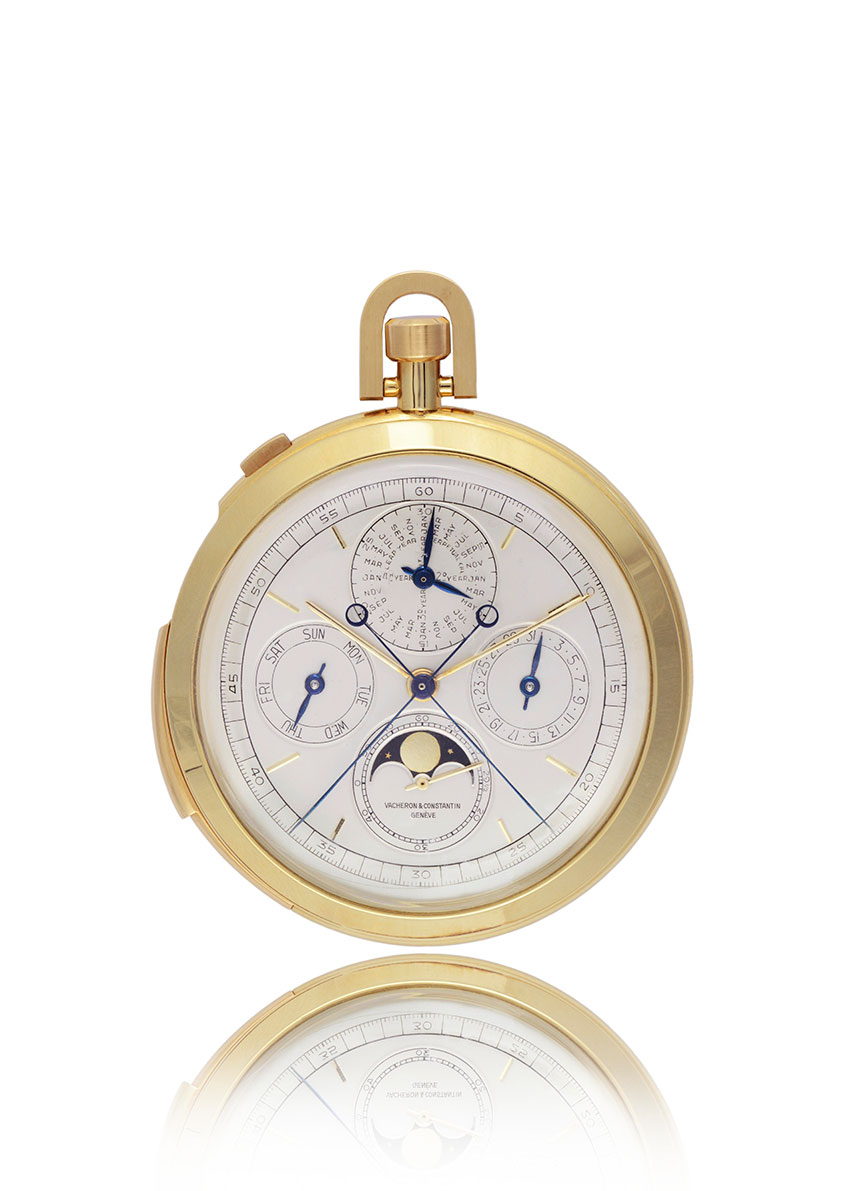
The heyday of the perpetual calendar
Throughout most of the 20th century, Vacheron Constantin remained faithful to its classic and elegant approach to horological complications, including the perpetual calendar in pocket watches until the 1960s. These decades were thus punctuated by a number of exceptional creations, including this gold pocket watch from 1946 with minute repeater, chronograph and perpetual calendar displaying the phases and age of the moon. Elegance was notably expressed by models featuring impressive slimness made possible by their thin movements. In 1955, Vacheron Constantin had already presented its manual-winding Calibre 1003, which was barely 1.64 mm thick, a real feat. Some 12 years later, the company achieved a new feat – this time in the field of self-winding movements – with its Calibre 1120 measuring 2.45 mm thick. It was this specific movement, skeletonised for the occasion, that served as the basis for the first perpetual calendar (Calibre 1120 QP) housed in an ultra-thin wristwatch introduced by Vacheron Constantin in 1983.
While complete calendars, triple calendars with moon phases and retrograde calendar indications are part of the grand traditions of the Maison, the perpetual calendar remains one of its preferred complications, currently interpreted in the Patrimony, Traditionnelle and Overseas collections. This inclination has notably been reflected in a major new model presented in 2019 with the Traditionnelle Twin Beat perpetual calendar . With its two going trains operating at different rhythms, the watch can be slowed down to a “resting position” ensuring at least 65 days of power reserve. In its “classic” version, the perpetual calendar also remains a basic function of grand complication mechanisms, an unchanging tradition at Vacheron Constantin. In recent years, the Manufacture has distinguished itself with timepieces whose complexity has become an art in itself, such as the Tour de l’île with its 16 watchmaking and astronomical complications, produced in 2005 for the 250th anniversary of the Maison. Ten years later, for its 260th anniversary, Vacheron Constantin presented another timepiece destined to make watchmaking history, the Reference 57260 and its 57 complications, making this one-of-a-kind model the most complicated watch in the world.

Astronomy at its peak
At Vacheron Constantin, mastery of astronomical functions is by no means confined to calendar functions. In the world of pocket watches, the Manufacture responded at an early stage to specific requests from customers and collectors who were particularly sensitive to this dimension of watchmaking. In 1890, for example, at the request of a Parisian client, the Manufacture created a watch indicating sidereal time. Some 20 years later, the company archives mention a movement blank designed to power a display of true solar time, associated with a simple calendar as well as sunrise and sunset indications. The year 1919 was also marked by the delivery of a perpetual calendar movement with moon phases, sunrise and sunset and retrograde equation of time, a true mechanical rarity. This tradition of astronomical indications based on the course of the stars – which been put on hold for a time due to the miniaturisation requirements of the wristwatch – has made a major comeback in the Maison’s collections since the powerful late 20th century craze for mechanical watches and has been further strengthened since the creation of the Les Cabinotiers department.
Responsible for special orders and exceptional creations for the Maison in the form of one-of-a-kind timepieces, this department has produced veritable masterpieces in the field of astronomical watches with highly sophisticated complications. Among these is the Celestia Astronomical grand complication 3600 (2017) and its 23 functions inspired by astronomy, including a reading of civil, solar and sidereal time. This same reading is found on the Astronomical striking grand complication – Ode to music (2020) and its 19 essentially astronomical functions coupled with a minute repeater. The theme chosen for the Les Cabinotiers watches introduced in 2021 was Le Temps Céleste (celestial time), masterfully expressed through three exceptional timepieces. Among them are the Armillary perpetual calendar – Planetaria watch, featuring a jumping retrograde perpetual calendar regulated by a double-axis tourbillon and complemented by a 3D depiction of the two hemispheres for the 24-hour and day/night indications. Expressed at this level, astronomical complications are undoubtedly both science and art.

A beautiful tribute
In the 19th century, Vacheron Constantin’s reputation was well established, particularly in the world of accuracy, which earned the company numerous prizes for excellence in chronometry (precision timekeeping) awarded by the Geneva Observatory, among others. The Manufacture’s customers therefore increasingly placed orders for timepieces meeting their needs, which were strictly formulated when it comes to astronomical observations. A letter addressed to Vacheron Constantin on February 24th 1853 by Count Hyppolite Salino, secretary of the Sardinian Legation in Paris, features a request for a thermometer and date watch: “(…) as I intend to use this watch for astronomical observations, I would like it to be a true chronometer, crafted with the perfection that the works emerging from your workshops come so close to attaining”. A glowing tribute to the watchmaking excellence of Vacheron Constantin.
************************
Watch selection
Double-sided yellow gold pocket watch with 48-month perpetual calendar and moon phases –1884
This is the first recorded Vacheron Constantin pocket watch to incorporate a perpetual calendar and features a double-sided display. The display of time including small seconds appears on the front enamel dial with Roman numerals and external minute-track, while the perpetual calendar is displayed on four counters visible through the transparent caseback. The vertical axis features the date and the day of the week, while the age and phases of the moon appear on the horizontal axis opposite the month display. This subdial divided into four quarters is staggered over 48 months with the leap year indicated by the same hand. This timepiece is all the more remarkable in that it won a First Prize for chronometry at the Geneva Observatory competition.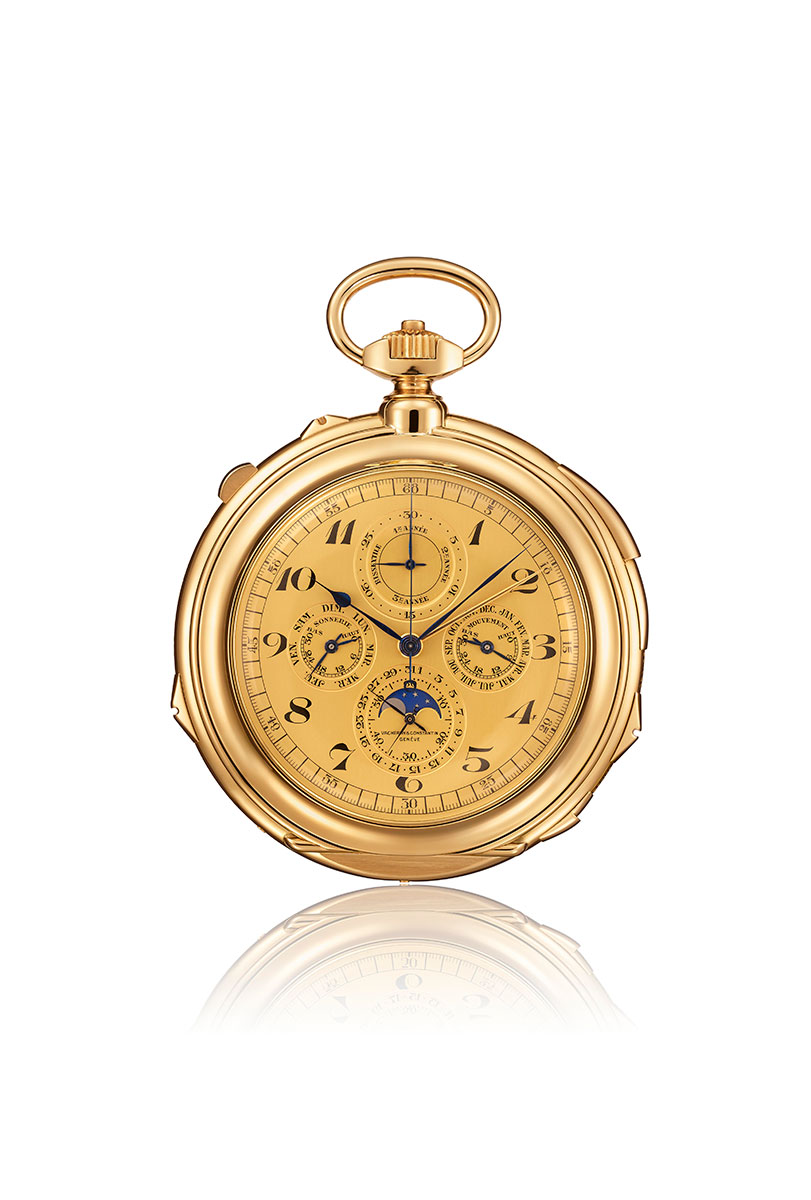
Grand Complication yellow gold pocket watch with tourbillon, perpetual calendar, moon phases and split-seconds chronograph – 1931
This extremely complicated watch is a collector’s item. A very rare model for its time, it displays a perpetual calendar with the age and phases of the moon, together with a split-seconds chronograph as well as a 32-hour power reserve indication. Regulated by a tourbillon, which can be seen by lifting the cover protecting the caseback, this watch won First Prize in the 1934 Geneva Observatory competition. Produced in 1931, it is a perfect example of the golden age that Vacheron Constantin experienced at that time in the production of pocket watches with multiple complications, perfect readability and infallible chronometry.
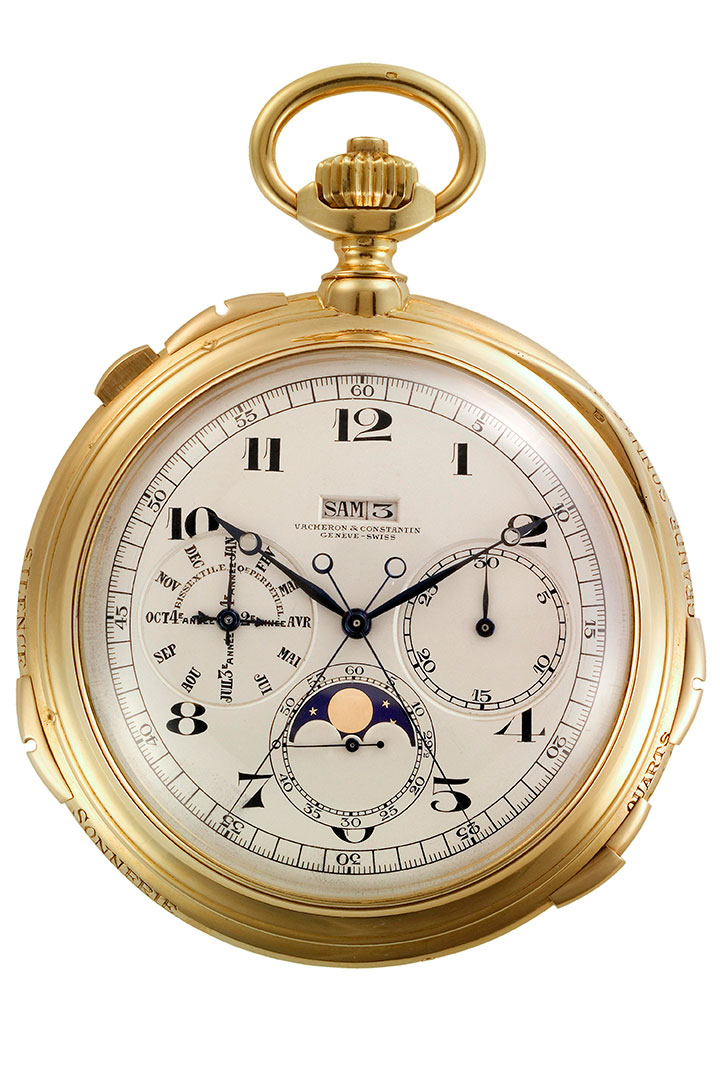
King Farouk yellow gold Grand Complication pocket watch – 1934
One of the most complicated watches of its time. This imposing model – measuring 80 millimetres in diameter and which took more than five years to complete – is equipped with 13 hands. Its calibre incorporates 820 components that drive 14 complications. This double going-train watch in 18K yellow gold was presented to King Farouk of Egypt in 1946 and remained in his collection until 1954. It includes a chiming minute repeater and Grande and Petite Sonnerie equipped with three gongs and three hammers, a split-seconds chronograph with a 30-minute counter, a perpetual calendar, an indication of the phases and age of the moon, an alarm clock and two power-reserve indicators.
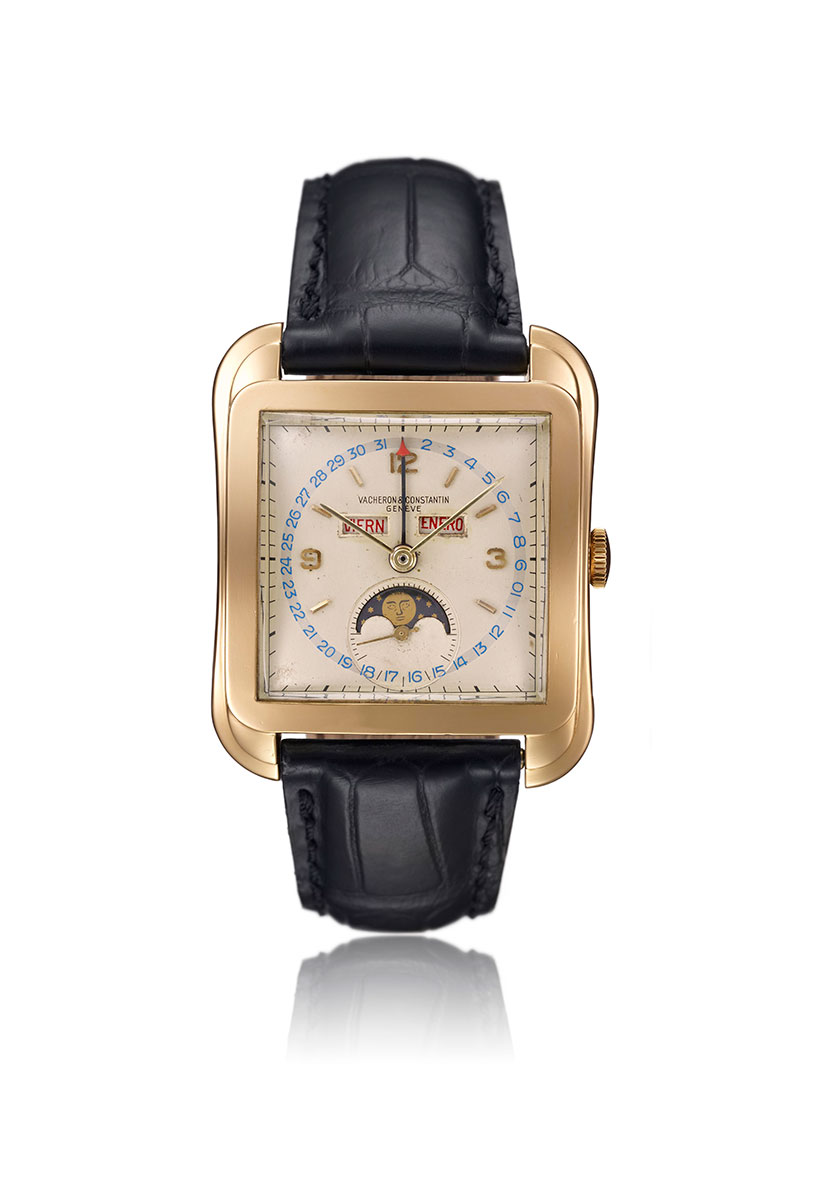
“Cioccolatone” yellow gold square curved wristwatch with triple calendar and moon phases – 1954
In the 1950s, post-war exuberance led to new forms of design that were both functional and unrestrained. Vacheron Constantin’s response to this new trend took the form of this large, organically square wristwatch with rounded lugs and bezel, as well as a slightly curved case. Nicknamed “Cioccolatone”, this watch has become an iconic symbol of the design typical of that period. Introduced at the beginning of the decade, it has been interpreted through several variations, including this most emblematic Reference 4764 with triple calendar and moon phases.
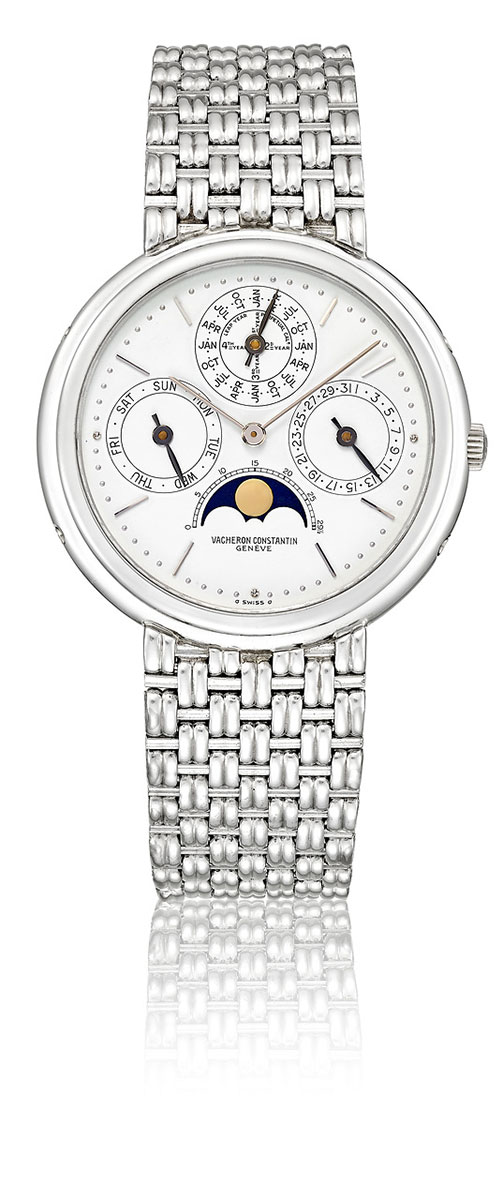
Ultra-thin platinum wristwatch with perpetual calendar and moon phases – 1988
At the height of the hegemony of quartz watches in the 1980s, Vacheron Constantin took a gamble on the mechanical watch by producing this complication watch, the first perpetual calendar with moon phases on a wristwatch from the Maison, which was also offered in an ultra-thin version. This model played an important role in the renewed interest in high-end watchmaking and its complicated mechanical watches. Presented in 1983, this reference –interpreted through several iterations including a skeleton version – remained in production until 2006. The watch is particularly elegant thanks to its movement measuring barely 4.05 mm thick: the ultra-thin Calibre 1120 QP complete with date module.
Les Cabinotiers Celestia Astronomical Grand Complication 3600 – 2017
The unique double-sided Celestia Astronomical Grand Complication 3600 combines astronomy and the art of watchmaking in a “celestial” white gold composition. The watch incorporates 23 mainly astronomical horological complications appearing on both sides of the case, offering a reading of the time in three different modes – civil, solar and sidereal – each driven by its own gear train. Its new fully integrated calibre has nearly 514 components housed in a thickness of barely 8.7 mm, while six barrels guarantee it a three-week autonomy.
Les Cabinotiers Tourbillon armillary perpetual calendar – Planetaria – 2021
Equipped with the new manual-winding Calibre 1991, the result of four years of development, this one-of-a-kind timepiece features a perpetual calendar with a retrograde display of the date, day and month. It also features a rare 3D depiction representing the Earth’s Northern and Southern hemispheres. The two titanium globes perform a complete rotation in 24 hours complete with a day/night indication. The movement is regulated by a dual-axis tourbillon whose interlocking cages move at a speed of 60 seconds per rotation.



